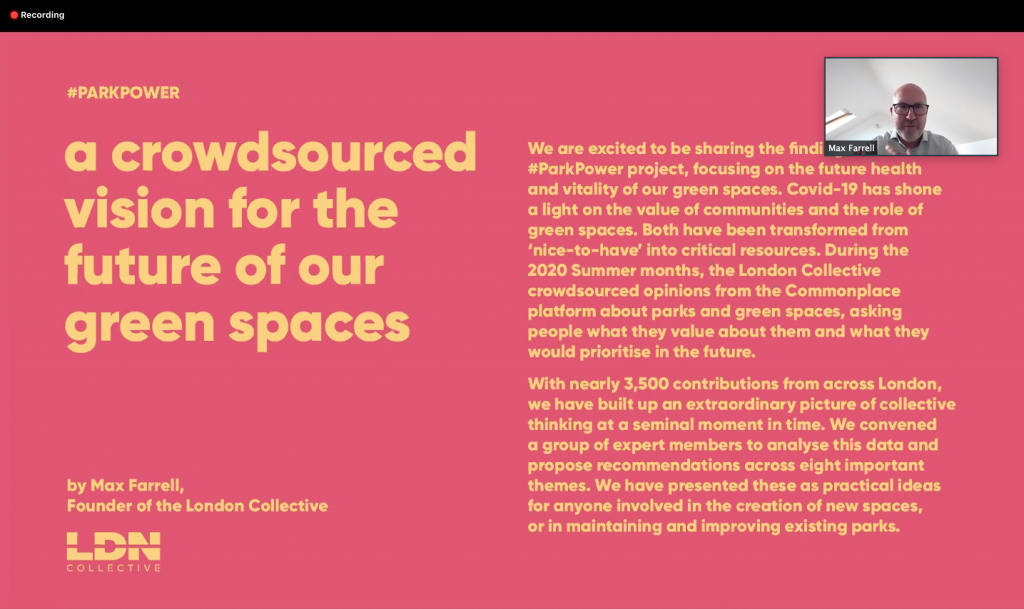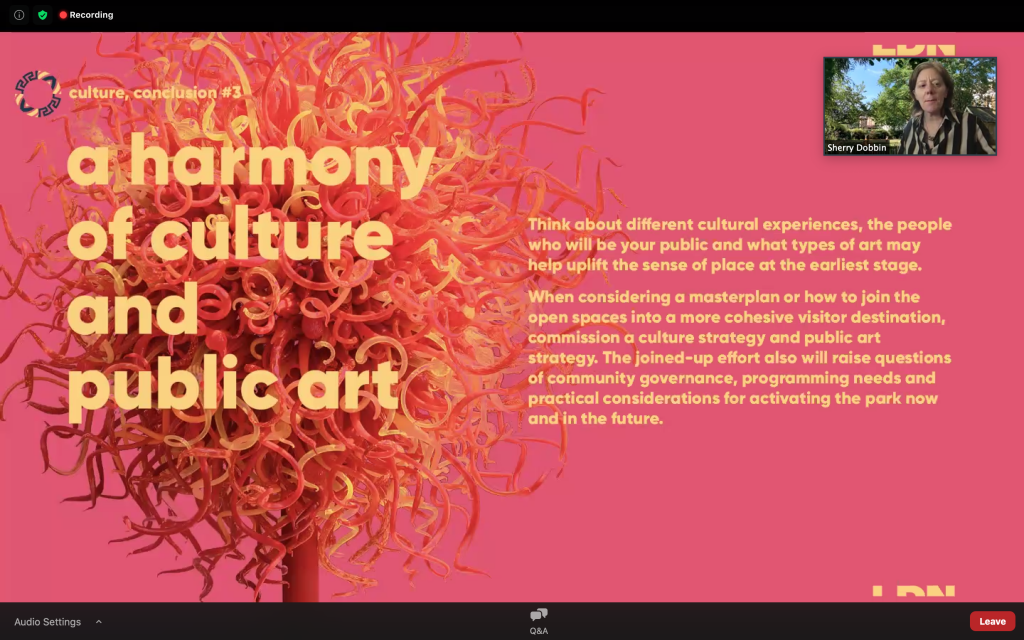Digital Dialogue between Ailish Christian-West (Director of Real Estate, Get Living) and Yasmin Jones-Henry (Strategist, Futurecity)
The London Collective, partnering with technology and digital solutions leader Siemens, the City of London Corporation, international building consultancy DAR Group and build-to-rent neighbourhood operator Get Living, has launched the #ParkPower report – a Crowdsourced Vision for the Future of Our Green Spaces, with four key recommendation areas for those who own, manage and design urban parks:
- Community cohesion: create spaces to enable joint creativity, incidental meeting, arts and music, and local identity-building
- Protect and increase natural capital: support wildlife, improve biodiversity, rethink plant palettes, experiment with food growing
- Improve accessibility, mobility and connectedness: start a green link network, reprioritise pedestrians and people with disabilities
- Embed technology that enables: capture the right data to inform decisions, build digital platforms to enhance park use, install smart lighting, bins and gates, retrofit green tech to generate energy.
Yasmin Jones-Henry, Strategist at Futurecity (who contributed to the ‘Culture’ section of the publication), sat down with Ailish Christian-West, Director of Real Estate, Get Living, to discuss the value of green space, and what she believes policy makers and developers should prioritise going forward.

YJH: With Lockdown 2.0 unfolding – looking back at some of the unexpected positive effects of the COVID-19 crisis, have you witnessed any of the widely discussed trends of renewed interest in green spaces with any of Get Living’s developments?
ACW: We definitely have. In some cases we’ve had customers coming from areas less well served with green spaces. Despite reports of people leaving London to move out to the suburbs, I think the green spaces have been a pull for new residents and other neighbours to remain in London. We’ve been able to retain our residents because they’ve been able to engage and benefit from our green spaces.
At East Village we have 25 acres of open green space, including a beautiful wetlands, play areas and grassy parkland. Our green space became the centre of the village when more than 6,500 residents were mostly working from home.
We witnessed it in sheer numbers sitting out on the grass, going on runs, using the brick bbqs. We called every resident those first few weeks of lockdown to check in – and many were saying how both being able to walk outside for their daily fresh air but also overlooking the green resident courtyards and out to the green public space was a lifesaver.
We’re also on the edge of Queen Elizabeth Olympic Park and that became a real extension of the neighbourhood for many residents, exploring up the Lea for the first time or just further than they had before. We also know that people from the wider local area found East Village for the first time as they were drawn to spend time in the green space too
As people re-examine how they want to live and with the increase in working from home, outside space has become an important factor. That’s balconies and quick access to a park – and in Manchester we’re on the canal and finding riverside is also a draw. We also found that our Google reviews this summer were more likely to mention the green space.

YJH: Do you feel Lockdown has meant more time outdoors in green spaces for you personally?
ACW: Absolutely, my daughter learned to ride her bicycle this summer, which involved lots of practice in the park, followed by fun family picnics. My children love trees, particularly ones they can climb.
So I am not surprised that Londoners have recognised that green spaces play a huge role supporting families to enjoy quality time together. I have wonderful memories of spending time with my family in our local park this year.
YJH: In your opinion, how do you feel developers and policy makers could (or should) engage with Londoners in the reimagining of their parks? What should they prioritise?
ACW: This report is a fantastic resource for developers and policy makers, I see it as the voice of Londoners telling us what they value and how they would like to see their green spaces and I think it is important that we continue to listen and understand how we can evolve our green spaces. One of the priorities is to ensure parks remain accessible and I really liked that parks service as an opportunity to connect communities and bring culture to life.
YJH: With over 25 acres of green space, The Wetlands is perceived as the green jewel in East Village E20’s crown, what is your vision for this sought-after site?
I want to see residents and neighbours of East Village to enjoy this space in whatever way supports their own ambitious or needs, supporting them to relax and break from whatever keeps them busy, enables great connections with family or friends in an environment that they value and can access at anytime they choose.. it can be a great place to walk, sit or run. I also want to ensure that while we are maximising the benefits for those who use the space, we minimise our impact on the environment and ensure it can continue to deliver for East Villagers for centuries ahead.

YJH: “Space, Time and Choice” is the Get Living mantra – how do you feel this philosophy will inform and influence the reimagining of green spaces across London?
ACW: Space, Time and Choice helps us reflect on what makes a neighbourhood a great place to live. Green spaces are absolutely key to that and these are picked up in the report:
Space – giving people a space to think. In a densely populated city like London we all need somewhere to breathe, get perspective, get beyond our screens. And we need everyone to benefit – we need to ensure these spaces are and continue to be accessible
Time – We need them on our doorstep to maximise the time we can spend in them. It’s all about location – no one wants a long park commute, so how can new developments include green space? The report also makes clear we need to invest time in managing these spaces, and in engaging with local people in how they’re used.
Choice – green space doesn’t just have to be a lawn and some trees – the report shows well how different types of parks and usages are valued. Fitness and culture, as well as playgrounds and picnics should all influence how we reimagine our green spaces and give our communities choice.
To Download the Park Power e-book LINK HERE
To read Futurecity’s contribution about Culture in Parks: LINK HERE
For more projects featuring Futurecity’s work on communities and healthy spaces
To give your comments on Park Power visit the Commonplace website
